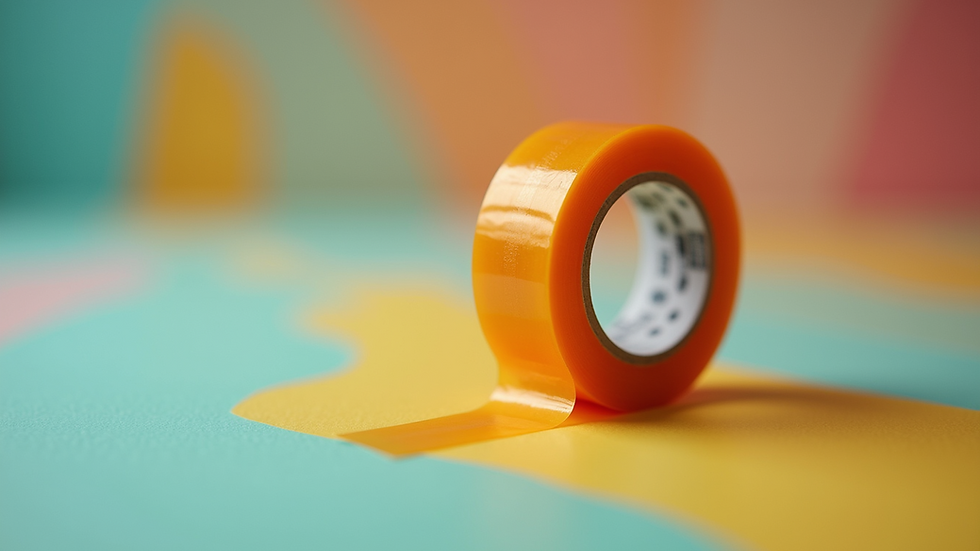Unwrapping the Impact of Cello Tape on Art and Craft for Kids
- Gopal Shah
- May 27
- 4 min read
Updated: Aug 22
Every year on May 27th, we celebrate a small yet significant invention that has transformed the way children create: cellophane tape, commonly known as cello tape. Often overlooked, this simple tool has become essential in the world of art and craft for kids. It not only aids in their creative processes but also brings joy and excitement to their projects.

A Brief History of Cello Tape
Cello tape was invented in the 1930s with the goal of providing a transparent adhesive to replace traditional sealing methods. Before its introduction, children relied on messy glue and complicated techniques that often frustrated budding artists. The clean, easy-to-use nature of cello tape changed this landscape, allowing for streamlined creativity.
Today, it maintains a strong presence in both homes and classrooms, with studies showing that nearly 80% of teachers keep cello tape on hand for projects. Its ease of use makes it ideal for everything from simple homework assignments to intricate art projects.
The Magic of Cello Tape in Art Projects
Children are naturally curious and creative, and art plays a vital role in their development. Cello tape empowers kids to experiment without fear. Its instant sticking abilities allow them to focus on their unique ideas, reducing the time spent dealing with messy adhesives.
For example, when creating a cardboard rocket ship, kids can easily stick on colorful paper and embellishments using cello tape. This supports their imaginative endeavors and helps them focus on what they want to create rather than the frustration of sticky glue.
Crafting with Cello Tape: Fun Ideas for Kids
Here are some exciting craft ideas using cello tape, perfect for home or school:
1. Paper Mache Projects
Cello tape can be particularly helpful in paper mache work. Kids can create projects by mixing glue and water, tearing strips of newspaper, and using cello tape to secure them to a balloon. Once dry, they can paint their creations. This activity not only fosters creativity but also develops hand-eye coordination as they work with different materials.
2. Collage Making
Children can cut images from magazines or printouts to create collages. Cello tape securely holds everything together while allowing them to rearrange pieces as desired. This flexibility encourages them to explore artistic composition, effectively using their imagination to craft unique designs.
3. Decorative Tape Crafting
Kids can personalize everyday items like notebooks or frames using cello tape and decorative washi tape. These personalized projects help enhance their sense of ownership, with studies showing that children who engage in personal art projects show a 15% increase in creative confidence.
4. Gift Wrapping
Introduce the spirit of giving by having children wrap gifts with cello tape. The process is quick and easy, allowing them to create lovely packages without hassle. This activity also teaches them the joy and importance of sharing.
5. Card Making
Kids can use colored paper, stickers, and embellishments to craft greeting cards. Cello tape ensures everything stays put, fostering a sense of pride in their handmade creations. Children often report that giving these cards makes them feel more connected to family and friends.
Tips for Using Cello Tape in Crafts
To get the most out of using cello tape, consider these tips:
Keep It Accessible: If kids know where to find the cello tape, they are more likely to use it spontaneously, sparking creativity whenever inspiration strikes.
Teach Proper Usage: Show children how to dispense the tape safely. This practice helps prevent tangles and frustrations that can disrupt their flow.
Encourage Experimentation: Let kids know that making mistakes is okay. Cello tape allows projects to evolve, so encourage them to try new techniques without fear.
Organizational Strategies: For larger projects, using containers or organizers can help keep tape and materials orderly, making the crafting process smoother and more enjoyable.
Cello Tape in Schools
Teachers have widely adopted cello tape in classrooms for arts, crafts, and decorations. Educators have noted enhancements in focus and engagement, as well as a significant reduction in mess. Teachers have reported that using cello tape saves an estimated 30 minutes of class time that would otherwise be spent cleaning up after glue spills.
Furthermore, because cello tape is often used in group projects, it fosters collaboration and teamwork among students. Children learn to share ideas, and the tape itself becomes a bridge that connects them in their creative journeys.
Celebrating National Cello Tape Day
As we recognize National Cello Tape Day, take a moment to appreciate how this simple invention has inspired creativity across generations. The design of cello tape has sparked countless hours of joy for children everywhere.
Encouraging kids to use cello tape in their art and craft projects not only helps in developing fine motor skills but also ignites a lifelong love for creativity. Let this handy tool open doors to exploration and expression in every child's artistic journey.
The Role of Cello Tape in Artistic Development
The humble cello tape serves as more than just an adhesive; it is a crucial tool nurturing the artistic spirit in children. From classrooms to homes, this simple device encourages creativity, exploration, and collaboration.
As National Cello Tape Day approaches, consider new ways to incorporate cello tape into your arts and crafts. Whether in schools or during home crafting sessions, cello tape is sure to continue inspiring creativity and artistic expression for years to come!




Comments